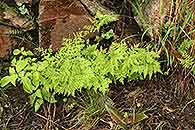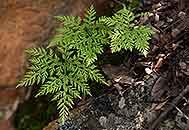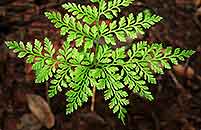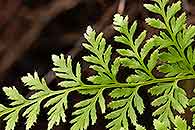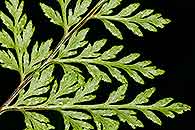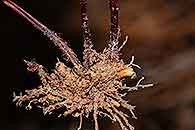Cheilanthes schimperi Kunze
Synonyms |
Aspidotis schimperi (Kunze) Pic.Serm. |
|---|---|
Common name |
|
Description |
Rhizome creeping, c.5 mm in diameter, with many roots; rhizome scales narrow, margin entire, apex hairpointed, brown. Fronds monomorphic, tufted or closely spaced, erect, 15-50 cm tall, subcoracious. Stipe up to 28 cm long, dark brown to almost black, hairless but with a few brown scales at base when young. Lamina 4-pinnatifid to 5-pinnatifid on the lower basiscopically developed pinnae, roughly hexagonal to broadly triangular in outline, 5-20 × 7-25 cm; pinnules triangular in outline, 1.7-2 x 0.8-1 cm; ultimate segments linear, narrow, c. 10 x 2 mm, adnate and decurrent, with spaced, sharply, finely toothed margins, hairless on both surfaces; rhachis and secondary rhachis dark brown. Sori very small, in the sinuses of the teeth of the ultimate segments; indusium small, membranous, ovate crenate, formed from the inrolled margin. |
Notes | Could be confused with C. multifida which does not have toothed margins or very long basal pinnae. |
Derivation | schimperi: named after W.P. Schimper (1804-1878), German bryologist and plant collector in North africa and Arabia. |
Habitat | Rocky outcrops, on earth and streambanks, around boulder bases, on termite mounds in open forest and Brachystegia woodland. |
Distribution worldwide | See African distribution. |
Distribution in Africa |
Angola, Cameroon, Dem. Republic of Congo, Ethiopia, Malawi, Mozambique, Nigeria, Sudan and South Sudan, Tanzania , Uganda, Zambia, Zimbabwe. |
Growth form |
Lithophytic, terrestrial. |
Literature |
|
